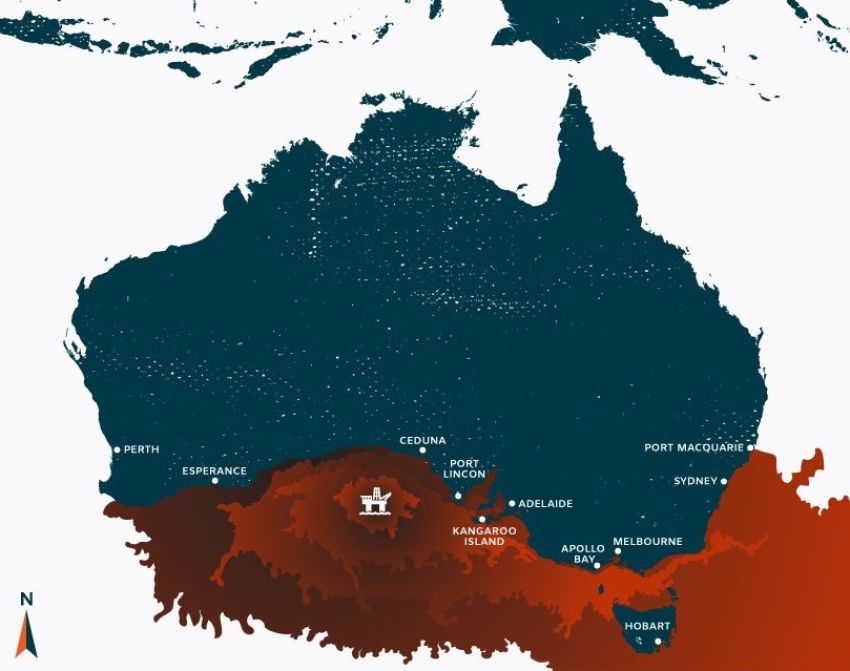
Barely three months after winning permission to drill for oil in the Great Australian Bight, Norwegian oil firm Equinor announced on February 25 it had scrapped plans for an exploratory well in the environmentally sensitive region.
Of the oil firms that hold exploration permits in the Bight, Equinor is the one whose preparations for drilling were reportedly most advanced. The company’s decision not to proceed with its Stromlo-1 well is an important victory for protectors of the Bight’s rich marine ecosystems.
With Equinor’s departure, four oil firms in recent years have dropped plans to explore in the Bight. But three remain: Santos, Murphy Oil and Bight Petroleum.
These companies and their backers in government are not giving up. Describing Equinor’s move as “extremely disappointing”, federal Resources Minister Keith Pitt stated that: “The Bight Basin remains one of Australia’s frontier basins.” Any proposals for new oil and gas fields in the area, he pledged, would be assessed “fairly and independently”.
In December, the National Offshore Petroleum Safety and Environmental Management Authority (NOPSEMA), the federal body that oversees offshore drilling, approved Equinor’s environmental program for Stromlo-1. This was despite criticism of the program from scientists and environmental activists and strong public opposition to exploiting the Bight’s likely oil and gas reserves.
For more than a decade, Greenpeace, The Wilderness Society and other environmental groups have been pointing out the extreme risks of developing the area for petroleum production. Early last year, a poll conducted for The Australia Institute found 60% of Australians and 68% of South Australians opposed drilling in the Bight. Only 16% of South Australians supported it.
A follow-up survey in November found 84% of South Australians supported the call for the Bight to receive World Heritage listing. At least 16 municipal councils along Australia’s southern coastline have voted to oppose drilling.
Both Pitt and Equinor’s Australia manager Jone Stangeland have been at pains to insist that the firm’s decision to quit the Bight was purely commercial. “We have received bids for the drilling rig, the helicopters, the supply base,” Stangeland declared on February 25. “The cost for these activities is just too high.”
Equinor’s executives, however, would have had no doubt that the project was certain to encounter persistent opposition. To assume this did not influence their decision to pull out would be naïve. The case mounted by marine scientists and environmental campaigners to halt drilling in the Bight is overwhelming. It shows the risks that oil corporations are prepared to take to secure profits.
Rich ecosystems
The ecosystems of the Bight are among the richest not only in Australian waters, but anywhere in the world. Spilling up over the edge of the continental shelf, upwellings of nutrient-rich water spur plankton growth on a scale comparable to the legendary systems off the coast of Chile and South Africa. The plankton provide the basis for an exceptionally productive and diverse food chain.
Studies reveal the presence in the Bight of about 300 species of fish, of which an estimated 85% are unique to the region. At least 17 species of whales and dolphins, including the endangered blue whale, have been recorded there. Also present are Australian sea lions, New Zealand fur seals, great white sharks, two species of turtle, and countless seabirds.
The Bight supports important commercial fisheries, above all of southern bluefin tuna. According to The Australia Institute’s Noah Schultz-Byard, more than 10,000 jobs in fisheries, coastal tourism and aquaculture in South Australia rely on the health of the ocean offshore.
A major oil spill would wipe out much of this wealth, both natural and economic. According to an analysis cited in 2018 by The Guardian, the “worst case discharge” for a potential accident at Stromlo-1 would have been 7.9 million barrels — the largest accidental oil spill in history and approaching twice the scale of the 2010 Deepwater Horizon disaster in the Gulf of Mexico in 2010.
Oil spill spread
How far would the oil from such a disaster spread? Equinor’s own modelling, leaked to Greenpeace in 2018, showed oil deposited on the coastline from Albany in Western Australia to Port Macquarie on the NSW north coast.
A 2018 report prepared for Greenpeace by marine conservation specialist Professor Richard Steiner concluded that even with a relatively small discharge, 5% of the “worst case”, oil could extend as far as New Zealand. Damage to ecosystems would be “serious and long-term”.
Equinor’s Stangeland maintained that his firm could drill safely in the Bight, improbably citing as proof the fact that NOPSEMA had granted its approval.
But, what are the real dangers of trying to develop this oil and gas province? Stromlo-1 was to be drilled at an extreme depth of more than 2200 metres, compared with 1600 metres for the Deepwater Horizon well. Moreover, the surface conditions in the Bight are exceptionally challenging: constant winds and heavy swells, with storm waves as high as 16 metres.
Halting the oil flow after the Deepwater Horizon explosion took 152 days, at a site just 66 kilometres from the US Gulf Coast with its petroleum industry infrastructure. The Stromlo-1 site would have been 372 kilometres from a near-vacant coastline, with accident control personnel and equipment days or weeks away. How long would a spill from Equinor’s well have lasted?
The dangers to the marine environment from oil drilling in the Bight are simply unacceptable, even without the impact on the global environment of the additional carbon pollution.